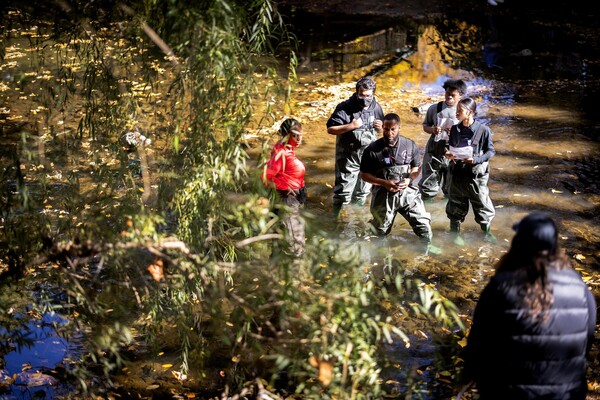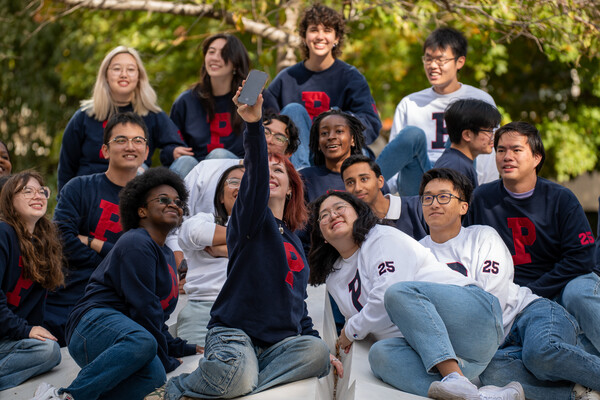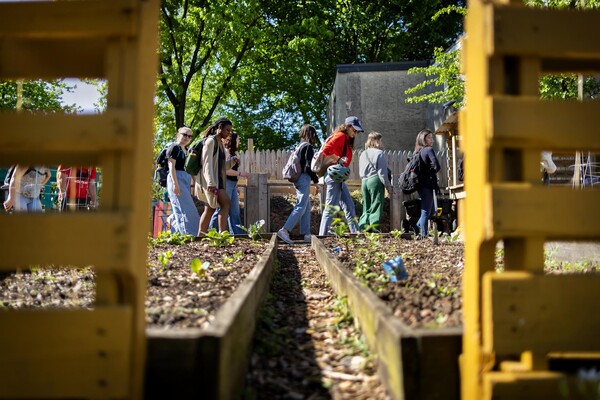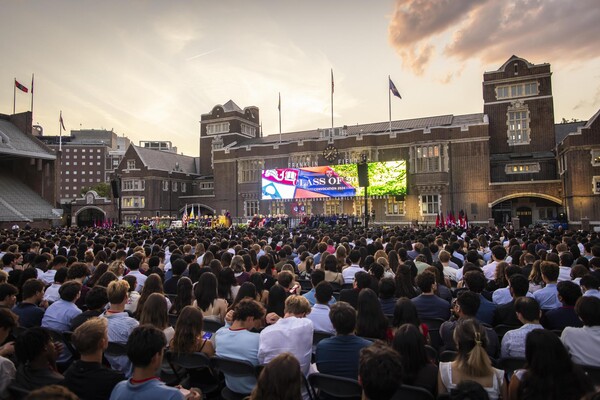A Q&A with SEAS Dean Eduardo Glandt
It’s been a heady decade for Eduardo Glandt, dean of the School of Engineering and Applied Science. He took the reigns of SEAS in late 1999—the end of a century that saw Penn introduce the world to ENIAC, the first general purpose computer, and also witnessed the development of the internet, cell phones, digital cameras and micro medical surgery. It’s been his charge to take an early gauge of the 21st century and prepare Penn to be a leader in that brave new world.
That mission has taken Glandt around the globe to meet with giants of new technology and into fields of study that focus on the smallest particles of matter currently known to humankind. It’s led him to believe that we are in the midst of a new golden age of invention and the leaders of this era will be the men and women who understand the importance of interdisciplinary collaboration. Coupling scientific findings with practical applications, a principle Benjamin Franklin espoused as long ago as 1740, will be more critical than ever before, he says, and having the ability to pair an exceptional understanding of technology with firm foundations in economics, sociology and biology will be key. Glandt intends for Penn to offer what he calls “a larger menu of knowledge” to provide students with the flexibility these times require.
To that end, Glandt has strived over the past decade—he jokes that his job is a footrace that goes “24/8”—to equip SEAS students with the finest facilities, the best faculty and the opportunity to conduct cutting-edge research. He has overseen the construction of two new buildings: the Melvin J. and Claire Levine Hall that houses the Weiss Tech House and the General Robotics, Automation, Sensing and Perception Laboratory; and Skirkanich Hall for bioengineering. And later this year, he expects to celebrate alongside Dean Rebecca Bushnell of the School of Arts and Sciences, the groundbreaking of the Krishna P. Singh Center for Nanotechnology, a 100,000 square-foot, $80 million facility that will transform the eastern entrance of campus at 32nd and Walnut Streets.
Of course, Glandt says, the heart of SEAS does not lie in its buildings, but in its faculty and students, and that is why he is particularly proud of the eminent professors he has recruited, as well as the recent 32 percent rise in undergraduate applications to Penn Engineering.
Born and raised in Buenos Aires, Argentina, Glandt first arrived at Penn in 1975 to earn his master’s degree in chemical engineering, and stayed to acquire a Ph.D. in 1977. He was appointed an associate professor of chemical engineering in 1981 and became chair of the Department of Chemical Engineering in 1991.
The Penn Current sat down with the dean that many refer to as “the most charming man at Penn” to discuss the dizzying speed of new developments in science and technology, whether the economic downturn has affected the rapid growth of SEAS and his enduring love for his adopted home of Philadelphia.
Q. How close have you come to the goals you set when you became dean in 1999?
A. When I took office we made a strategic plan and that plan has three stages. We decided to execute those stages sequentially. It so happens that, lucky as I am, I began during the IT bubble in the late 1990s and early 21st century and that demanded that our first priority would be information technology and computer science. So, we invested in IT and computer science heavily. We built a building for that department called Levine Hall, which is my first-born baby [laughs]. People say it looks just like me. It’s a large and very vibrant department, and it’s appropriate that we remain on the groundbreaking frontier of this area because ENIAC was developed here and we were one of the first places to offer any type of degree in computer science. We were pioneers in the field. But then in 2002 the IT bubble burst, as everyone knows, and it was time for us to move our attention to the next stage.
Q. What was that next stage?
A. Everything that has to do with ‘bio.’ Bioengineering. Biotechnology. Bioengineering is to this day the largest major in this school by far. Part of the reason is that we have a prominent medical school half a block away. Whereas Cornell’s med school is in New York and Johns Hopkins’ is across town, ours is half a block away and the academic mission in our School of Medicine comes first; the CEO of the medical system reports to the dean. It’s a technical but important detail, because it means our undergraduates are welcome over there. In this stage, we got a lot of important support, including $14 million from the Whitaker Foundation. We built a building, Skirkanich Hall, which is getting one of the top architecture awards in this country [the 2010 Institute Honor Award for Architecture from the American Institute of Architects]. In addition to having fantastic bioengineering labs both for teaching and research, it is an object of beauty. So, we focused on our strategic advantage of having Penn Medicine nearby, and we hired the best of the best in bioengineering. And now, we are facing the third and perhaps the most important—definitely the costliest—of the three phases, nanotechnology.
Q. Why do you call it perhaps the most important?
A. Because nanotechnology is the next wave of technology generation, the next wave of wealth generation and the next wave of permanent change in our culture, just like IT was. Do you remember how we lived before email? Before the cell phone? Before the internet? We don’t remember that because technology changed the culture. The same thing will happen with nano. We have been hiring an amazing faculty, and the plans for a new building have been finalized and we will break ground this year.
Q. You’re talking about the Krishna P. Singh Center for Nanotechnology?
A. Yes, it is going to be at the 3200 block of Walnut Street, on the north side of Walnut as you arrive on campus. It will be the gateway to the campus, and it’s a project that will benefit Penn, the city and the region. It will be a facility that will give people access to cutting-edge instrumentation. Nanotechnology is a field that is what deans call ‘facilities intensive.’ You can have great people, but in this field the instruments that your institution has will define you more than anything else. For example, you buy a million-dollar electron microscope, and then the maintenance contract is $100,000 a year and it has to be run by staff with Ph.D.s ... this is demanding equipment.
Q. You said the building will be for the region; can you explain that?
A. This is a building that will be owned by Arts and Sciences and SEAS, and we are going to welcome—warmly welcome—users from across campus, from other campuses in the region and from outside the University. Nanotechnology is interdisciplinary in nature, and the center is going to expand Penn’s opportunities for collaboration across departments, across institutions and across sectors. We are going to welcome any company that wants to use it. We are going to have offices for them to rent, and we are going to offer technical concierge services. We will really reach out to build partnerships.
Q. Is there another nanotechnology center in the Philadelphia area?
A. No, the closest is at Penn State or Cornell. I like to say proximity is an intellectual value.
Q. If the groundbreaking takes place this year as planned, when will the project be complete?
A. The building itself will be finished by the end of 2012. Let me show you the building ... [Glandt launches a PowerPoint presentation on his laptop computer]. This is the site as it is today ... you see this low-rise red brick cube? That is the Edison building at 32nd and Walnut. That building contains all the electromicroscopy for this campus. Those microscopes will go in the basement of the new building. Electron microscopes have to be in a place with no vibrations. The new building will be farther from the street, and the microscopy will be in the basement. [Glandt displays architectural renderings of an airy and modern multi-story, L-shaped structure featuring walls of glass and steel built around a green courtyard.] Let me show you the first floor. What makes a building ‘nano,’ is a clean lab. I mean ‘clean’ as a technical term. It’s a lab where people go in through double doors, gowned up. There can be no dust, no dust at all. You can’t even take a pen in. That pen has to go through double doors and wind will blow on it to blow all the dust off. The wind blows on individuals, too. That is how I lost my hair [laughs]. This main floor will have a huge clean room—about 10,000 square feet—that will be behind glass for two reasons: for safety, because they are using gases; but also so visitors can see what is going on through the glass.
Q. Tell me about the event room.
A. Oh, it is a great architectural gesture. A cantilevered events place, it is a general-purpose room that is an overhang over the opening of the courtyard. It will be one the nicest rooms on this campus, I promise you, beachfront property. It will have a great balcony. It will be used for conferences, for lectures, for student events, for dinners, for whatever. ... I joke that I charged the architects that we wanted a room so nice that people will want to rent it out for weddings and bar mitzvahs. Now we refer to it as the bar mitzvah room. ... The building, which will be almost 80,000 square feet, has a roof garden and a grand stairwell with six generous landings and each landing will have booths where students can gather.
Q. As dean you’ve overseen the construction of three buildings in just over a decade. That is a lot.
A. Yes, it is. But the school was 50 years behind in facilities; there was such a great need for each of them. Of course, we have been lucky. Part of that luck was how technology came to the forefront so patently during this time, and how that put a spotlight on us. That rise in technology has created wealth among our alumni and they have been generous.
Q. Even with the economy taking a downturn?
A. Oh, we have seen evidence of the downturn. But fortunately we were advanced enough in our fundraising when the downturn hit that, although it now takes four times the amount of effort to raise the same amount of money, we are going ahead [with our projects]. We were over the tipping point when the downturn hit and that’s a blessing because to start now would have been impossible.
Q. I’ve heard you refer to the Singh Center as the new gateway to campus; why do you call it that?
A. The approach on Walnut Street, which is the main entrance to the campus, is a concrete gulch. The style of architecture in that area, which was popular in the mid-20th century, is called Brutalism. It’s the style of the ice skating rink on the south side of Walnut. I like to refer to it as Hitler’s bunker [laughs]. We need to green that entrance of the campus and we need to bring to that area of campus an icon. We are going to create that icon on Walnut Street with the beautiful Singh Center and its sloping lawn and sculptures that we have already selected for the courtyard.
Q. What about sustainability?
A. It will be green in many ways. Our architects [Marion Weiss and Michael Manfredi of the New York firm Weiss/Manfredi] are also landscape architects, as renowned as being landscape architects as they are for being traditional architects. The specification of every leaf, of every bush, of every tree was studied and selected carefully. We will collect the water. We will use local materials. The building will be LEED certified silver. It will be a very green building, and that is especially important because it is a glass building facing south. You owe it to yourself to make it energy efficient because otherwise you’ll be paying enormous bills every month.
Q. How do you explain to people just how dramatically the world of engineering has changed in such a short time?
A. It’s easy if you yourself are in awe, as I am, of what’s happening around us everyday. This school has evolved in my years to be a very cutting-edge school, a very high-tech school. In fact, it is one of the few engineering schools that does not have a program in civil engineering. Civil engineering is important, don’t get me wrong, but we don’t have a program for it. Information technology, biotechnology and nanotechnology, these are the three legs of our tripod. It used to be that engineering knowledge was applied to building houses, bridges and roads. Now, the frontiers are medicine, and health and the social sciences—think of the amazing nano wonders that have already been invented; pills that you swallow and they take pictures inside your body and broadcast them to the outside. Things like Google and social networks are applied engineering and social science, applied economics and game theory and engineers are the enablers. That is why we have a new major this year, which I am very proud of, called Market and Social Systems Engineering, which was made possible by a gift from Rajendra and Neera Singh. They are not the same Singhs of the building. The major will be an elite program to prepare students to start Google-like companies. There is technology knowledge involved, but also an entire economic science of how to design those systems. It works into the Penn Compact idea of integrating knowledge.
Q. I’m assuming this generation of engineers understands, almost innately, the necessary integration of all these disciplines?
A. Especially at Penn. Our students come to Penn because they are interested in taking advantage of a larger view, a larger menu of knowledge. We have a very clear identity.
When I talk to potential students and their parents, I talk about the students who are already here. A university shapes you through your student peers. Lots of important things are learned in the classroom, but many other important things like ambition, creativity, goals and ethics you pick up from your classmates. The students here are so amazing that as faculty we try to just not get in the way.
Q. I understand applications to SEAS were up significantly this year.
A. Thirty-two percent. It’s a national phenomenon that follows a historical pattern. When things are unsettled, it’s a good time to be an engineer. People turn to disciplines that are fundamental, that travel well and age well. Nonetheless, our application rate was even way ahead of that of our peers, and of course we are ecstatic. The question is whether this reflects a true sea change in our country, where so few kids used to study the hard sciences. Is it going to be a permanent change, or was it just a fluctuation due to the tough job market? I hope it’s the former, but we’ll see.
Q. Maybe it is a permanent change because this is a generation that lives with technology; that grew up with it as part of their everyday lives.
A. Maybe, but science is still considered scary to many and engineering is even scarier. There is a level of enlightenment that kids have to go through to see that they might enjoy studying it.
Q. Speaking of math and science being scary, I know you have focused on getting more women interested in engineering.
A. We have an amazing program called AWE, which stands for Advancing Women in Engineering. It reaches women at all levels, from junior high school all the way to faculty. It helps women create a community in engineering. We have special programs geared toward junior high school and high school girls, and lots of programs that support our female undergraduates. We have one program for undergraduates that invites them to campus several days before the other students arrive and we give them a leg up by making sure they are familiar with the place and the faculty. We want to make sure they are supported because we know that society pushes them in the other direction and we want them to be comfortable. This program last year had 20 students. This year, it was half of the women in the freshman class, about 75. We have an amazing person who runs the program, Michele Grab, who is young and energetic.
Q. Let’s talk about something new that you instituted this year, the Dean’s Medal.
A. We created the Medal three years ago, but the people to whom this medal would go are few and far between. It’s not something to be given every year. It is only to be given to the right person at the right time, and the first recipient was Mukesh Ambani [Chairman & Managing Director of Reliance Industries in India].
Q. What is the Medal meant to recognize?
A. The impact of technology. Mukesh Ambani presides over a very high-tech energy and chemical company, very high tech. They built this year, for instance, the largest refinery in the world, and the greenest. When you fly over it, you fly for an hour and you are still over it. Not a drop of cooling water, not one drop of effluent, leaves the plant. They use all the processed water to grow mango trees. Can you imagine going to the refineries in South Philly and seeing a jungle of mango trees? This company is one of the largest producers of mangos anywhere and they are all at a refinery. In India the impact of this is not only the creation of energy, but of jobs. They are creating a middle class. He employs 100,000 engineers. He is changing India not a million barrels of oil at a time, not a billion cubic feet of gas at a time, but one engineer at a time. And that is an impact on society. Around the world we see what is happening in India, and Mukesh Ambani is one of the main drivers of that change.
Q. I read that he and his wife are starting a university there; is that true?
A. Yes, they are. India has many institutes of technology, but they don’t have comprehensive universities. He wants a full-menu university that is of the caliber of an Ivy. They did that already at the much easier level of a K-12 school [the Dhirubhai Ambani International School] and it has become the main feeder of kids from Mumbai into the Ivy League.
Q. How often do you think you will be awarding the Dean’s Medal?
A. We have some people in mind right now, but it will only be awarded when we have the right person, a person who has made a significant societal impact. This is not a medal about scientific discovery. It is not about making money. It is about changing society.
Q. That is something I’ve heard you talk about as being the legacy of SEAS, of taking the principles of Benjamin Franklin into the nanotechnology generation for the betterment of society.
A. Well, what are the metrics of success when you are an engineering school? There is the creation of knowledge and the transmission of knowledge, but the ultimate metric is impact. It is also true for all of tech, not just engineering.
Q. I know when you started as dean you talked about raising the ranking of SEAS, have you succeeded?
A. It can be paralyzing to be looking at the rankings, so we have decided to simply do the right thing as an institution and the rankings will follow. We have built new facilities, we have hired amazing faculty and people are noticing. Our research funding has broken all records and that will influence the rankings. Our applications have broken records and that will influence rankings.
Q. When you were a kid, what did you want to be when you grew up?
A. I always wanted to be in science. But, I remember when I was in
high school I took a whole day of tests, for vocational orientation, and they said one word: architecture [laughs]. I remember being unsettled by that. My dad was a pharmacist; you know the old-fashioned kind of chemist who made potions and lotions. So my younger brother and I both became chemical engineers. I think perhaps your question is asking how much of my own future I envisioned. And in my life, more than my choice of a profession, the greatest change was immigrating to the United States.
Q. You mean coming to the United States was an unexpected turn of events?
A. It is what made my life totally different. From my high school and college years in Buenos Aires, you would never have extrapolated that I would be here in Philadelphia doing what I am doing today. I have gone through life surprised that I landed where I landed, very happy, but surprised. I am a lucky guy.
Q. Graduate school brought you here?
A. Yes, here to Penn. It was the first place in America that I experienced. Then, [after graduate school] I was supposed to go back to Argentina, have a faculty position there. But there was a coup in the ‘70s and my job disappeared and they decided to kill people, and the United States offered me an opportunity I couldn’t refuse.
Are you familiar with the notion of what is called ‘ovarian luck?’ It’s the notion that of all the things that happen to you, the greatest affect is where you were born. So, I was born in Argentina with the possibility of coming here, and somebody else is born in a far less fortunate place, like today’s Haiti, where the challenges they face are so much greater. I was very fortunate to end up where I ended up. I became an American citizen the day I was eligible.
Q. You go back to Argentina regularly, though, don’t you?
A. I am totally bi-cultural. I know Philadelphia, I’ve been here for more than 30 years, and I love it. But I go to Buenos Aires, I land there, switch languages to Spanish and I know every stone there as well. It’s like going through a looking glass. I think it makes life richer to know different cultures.
Q. Away from work, I hear that you renovated a historic house?
A. Yes, it’s a house from 1850, in Society Hill. It was derelict for many years. I bought it and had it gutted. Inside it is a great contemporary house, and outside it is a brownstone. That’s one of the great things about Philadelphia, the houses are all so interesting. I love this city, really I adore it.







